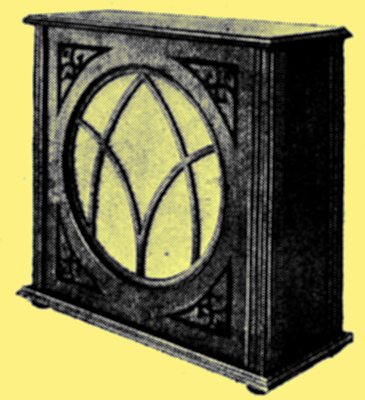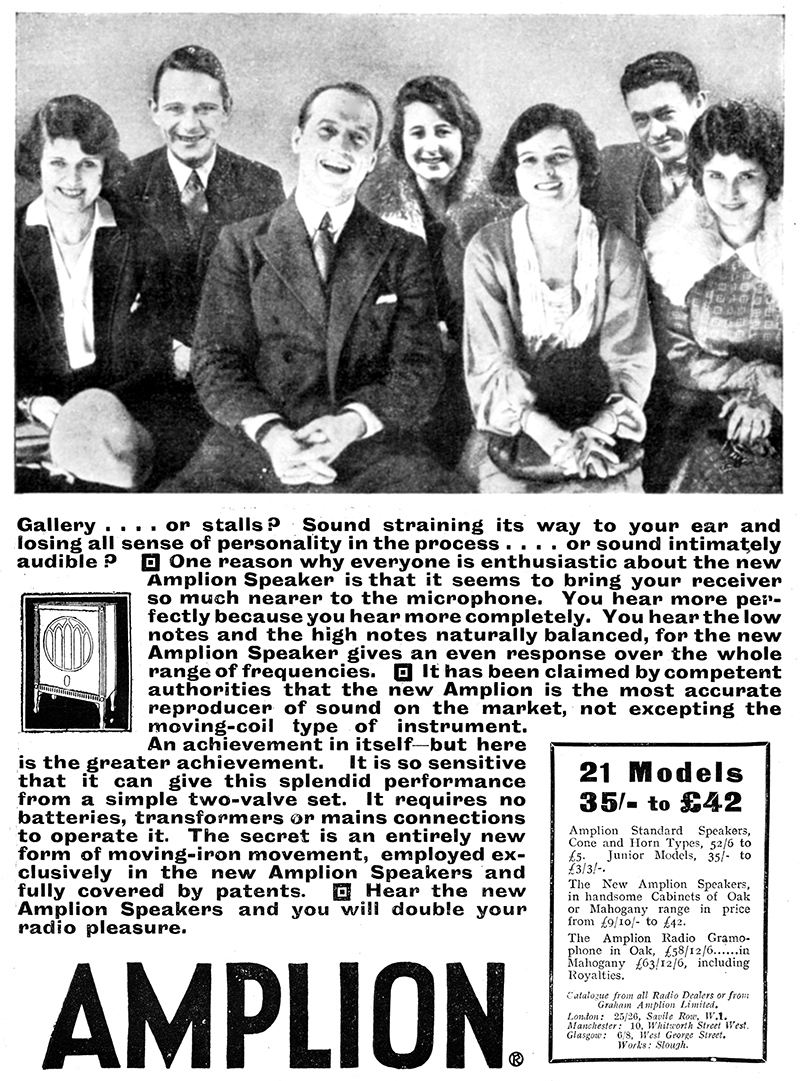|
Can the reed-driven loud speaker 'come back' and beat the moving coil type?

The latest reed-driven type - the Amplion Lion table cabinet model which sells for £10 16s 0d.
Within the last year or so the moving-coil speaker has gained marked ascendency over all other competitors - at least, where really high-grade reproduction is concerned. The claim is now made that it is possible to secure an equally high standard of reproduction on a reed-vibrated diaphragm, driven from a 'fixed' magnetic movement.
The moving-coil instrument is admittedly expensive both to install and maintain, more especially as an extra supply of current is generally necessary to energise the field windings of the magnet, which in most cases involves the addition of a mains-supply unit to the speaker outfit.
If the same musical qualities can be obtained without the use of specially energised field windings, this point will undoubtedly make a strong appeal to listeners who are not 'on the mains', and who shirk the inconvenience of maintaining extra battery power.
The merits of the new reed-driven speaker which is being marketed by the Amplion Co. as the Lion brand, depend in part upon a special construction of the conical diaphragm, and in part upon a particularly fine adjustment of the reed-armature relative to the pole-pieces of the magnetic movement.
The Diaphragm
The conical diaphragm is made of hot-press paper of such area and mass that whilst it vibrates as a whole for frequencies of, say, less than 80 cycles per second, for higher frequencies the surface 'breaks up', so that the effective area in vibration is less than the actual area of the diaphragm.
As the frequencies increase, so does the effective vibration area. The weight mass and elasticity of the reed is also specially calculated so that in combination with the diaphragm the overall frequency response remains constant from the lowest to the highest musical range, instead of tending to favour the higher notes at the expense of the lower as usual.
In the ordinary type of reed-driven speaker, the reed is mounted so that it normally lies parallel to the surface of the pole pieces.
Reed Movement
Under the influence of an increasing magnetic field, the reed moves downwards towards the poles. It does not, however, keep parallel to the pole surface during this movement. In its flexed position, the tip of the reed, i.e. the part farthest away from the pivot or point of support, lies nearer to the poles than any other part.
The magnetic field naturally concentrates itself across the narrowest point of the gap, with the result that, acting mainly on the tip, it exerts a greater leverage or torque than it would if the reed were maintained strictly parallel to the pole surface throughout the whole of the vibration period.
Even if the reed always moved parallel to the poles, the attractive force acting on the reed naturally increases as the reed moves nearer to the magnet. This effect is partly offset by the fact that the poles are already permanently magnetised, but it still exists to some extent.
When added to the increased average previously mentioned, the combined effect upsets the strict linear proportion that should exist between any variation in the applied current, the resulting mechanical vibration imparted, to the reed, and in this way introduces distortion.
In order to overcome this defect, the magnetic movement in the new Lion speaker is pivoted about a carefully calculated axis of rotation, the arrangement being such that, in effect, the pivot or support of the reed lies slightly below the level of the pole pieces.
Accordingly, as the reed is vibrated the nearest approach to the poles is made by an intermediate part of the reed, and not by the tip. The narrowest part of the gap is, therefore, moved over closer to the pivot or fulcrum, so that the leverage or torque applied by the magnet is decreased as the reed swings downwards, instead of being increased. The new mounting thus automatically removes a source of distortion that is inherent in most speakers depending upon a purely magnetic driving movement.

Full page advert from the same issue.
|